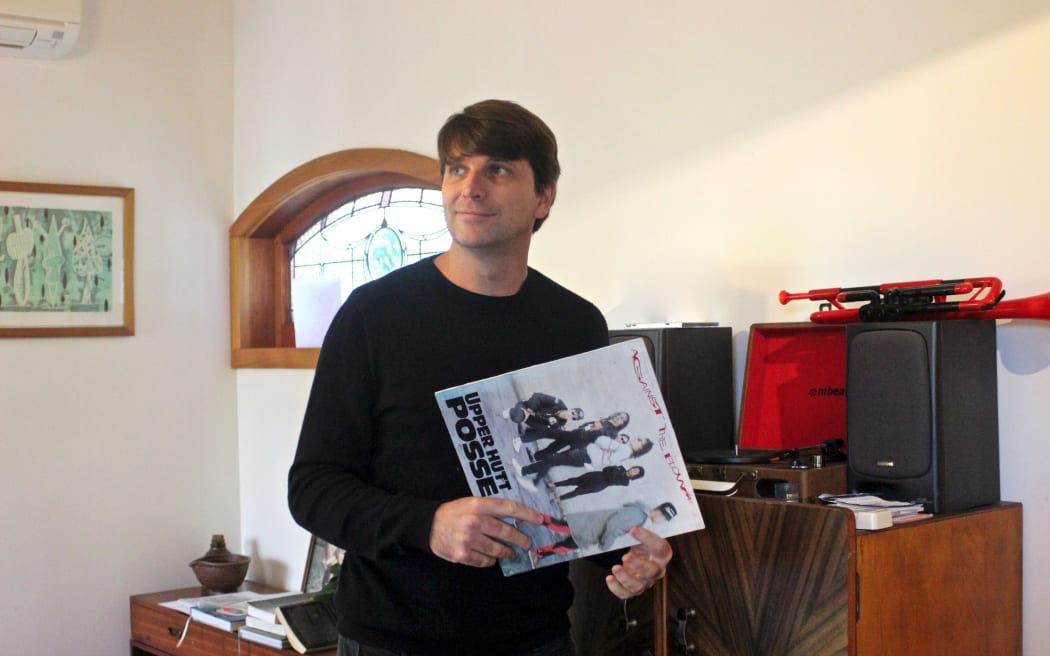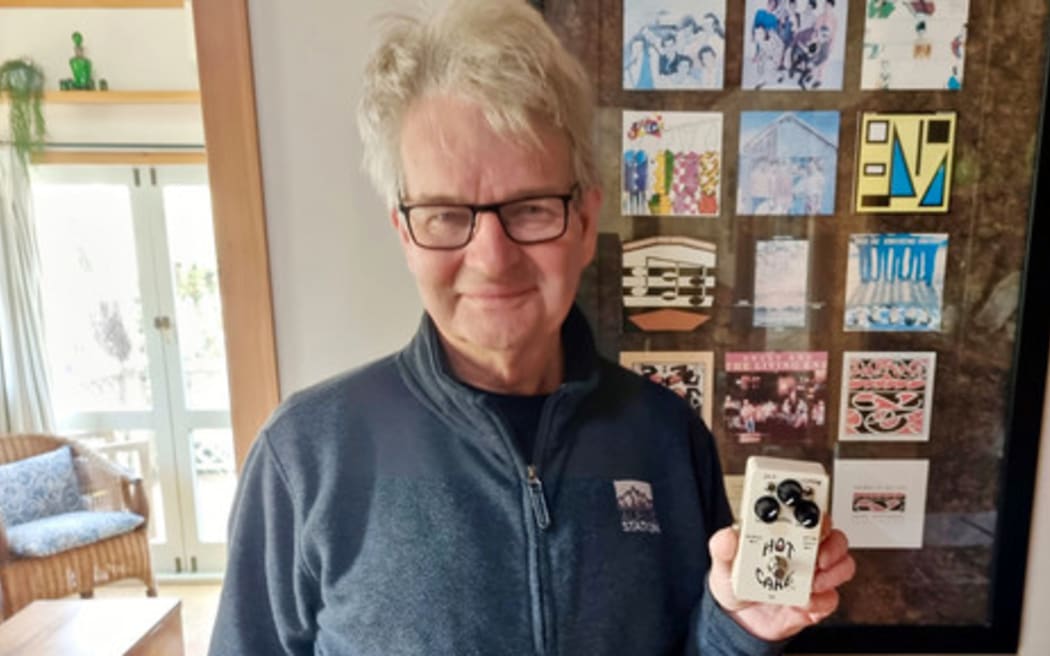From DJ software used by the likes of Fatboy Slim to an easier way of applying guitar oil, New Zealand inventors have come up with many innovative gadgets to aid and inspire music makers from around the world.
Music writer Gareth Shute has put together a list of a range of musical products that are designed, and often built in Aotearoa.
He talks to Max Towle about what makes these innovations so special.
A full breakdown of Gareth's list can be found on Audioculture here
“I wanted to get the range from the backyard garage-constructed ones to ones that are massive industry-leading worldwide companies like Serato, he told Weekends.

Gareth Shute with Upper Hutt Posse's E Tu album - photo: Mieko Edwards Photo:
The Ssshhmut
“Trevor Bremner is a cornet player. He's won all these awards. But when he had children, he started using a mute, so he could practise at home without waking up the kids.
“And he found either the mutes made the cornet go slightly out of tune, or you had to blow a lot harder. So, you're actually practising, but not learning good technique.”
And so ,in classic Kiwi DIY approach, he started to build his own mute, Shute says
“He got suitcase material and bits of brass and stuff and constructed one that worked way better.
“He then realised, wow this is a real goer, and then started swapping out those components with proper materials plastics and so forth.”
And so the Ssshhmut was born and word of mouth in the brass community spread, Shute says.
The product is now a family business manufacturing out of New Plymouth.
Saxmonica
“Nick Mulligan wanted to make a saxophone that you could carry in your pocket like a harmonica.
“He got a sax mouthpiece and a pipe. So it was just about adjusting the materials and making the fingering so that you could actually play tunes on it properly.
“And so it's a real garage construction the Saxmonica.
Boogie Juice
Developed by Simcha Delft, who's someone known for guitar repair and so forth around the New Zealand scene.
“They actually made this way back in the 80s when they were living in the UK and brought it here and started selling it themselves.”
The product cleans fretted instruments which are tricky to clean, Shute says.
“They made the cleaner into a pen where the liquid comes out the end of the pen and they can really scrub in there and clean it properly.”
The Hotcake

Photo: Gareth Shute
Kiwi Paul Crowther’s guitar pedals are legendary, Shute says.
He started making them in the late 60s and then when he was drummer for Split Enz.
His guitar pedal The Hotcake is now used world-wide, Shute says.
“Through the 80s I guess it was people like Neil Finn and Flying Nun bands using the Hotcake.”
Now guitarists such as Noel Gallagher, Keith Richards and Mark Knopfler use them, he says.
Musical Electronics library
The musical electronics library was created by experimental musician Pat Kraus, he says.
“There's a place in Auckland called the audio foundation library for experimental musicians, so he got volunteers there and they all made a whole bunch of these sound, effect units and put them on old VHS cases - so they look quite cool.
“But then you can plug amps into them or plug guitars to go through them and stuff.
“People can join the audio foundation library and actually sign up as members and borrow all these instruments he's made with the help of volunteers.”
Ekadek
The best thing about Ekadek is just how cool these machines look, Shute says.
“Greg Brice is really into analogue sounds has been working in studios since the ‘80s,
“And he just decided to make his own units, mostly from scratch or updating old ones. And so, he's made this whole range of studio equipment.
“There's one studio in Australia that entirely uses them, because they're super analogue.”
Unknown Mortal Orchestra made a whole album using one, he says.
The Synthstrom Deluge
“A cool little box that you can make electronic music with basically anywhere, you could do it at the beach or on the couch at home,” Shute says
It was started by Rowan Hill who studied computer science at Victoria University, Shute says.
“It’s this little box that's basically the size of like a coffee table book or something. But it's got all these buttons and knobs on the front of it. And basically, you can bring in sounds from the outside or you can create synthesized sounds, and then there's a piano scroll down the front so you can place them in the order of where they'd come in the song.”
Serato
Serato and the spin off company Melodics have created this whole hub of modern digital music making on Karangahape Road in Auckland, he says.
“The company started when in the ‘90s when Steve West a bass player wanted to play along with a song but slow it down so he could listen to it and learn the baseline slowly.
"But he found all those plugins back then warped the sound, they change key if you slow a song down."
As a university assignment he and fellow student, AJ Bertenshaw, developed software that could do the job, Shute says,
“They created software called Pitch and Time.”
It became a popular sampling tool with the likes of Fat Boy Slim using it, he says.
“But then people like filmmakers David Lynch, and George Lucas realised that it was really good for fitting songs into movies and if you wanted to slightly adjust the speed of them.
“So, Pitch and Time made Serato this massive worldwide company.”
Serato subsequently developed Scratch which became a huge product with DJs, he says.
“They took it over to NAMM, which is the National Association of Music Merchants and all the DJs in the US who saw this thing, were just amazed, like, especially the competitive kind of DJs.”
Melodics emerged from the same milieu he says.
It was started by the old CEO of Serato, Sam Gribben.
“Melodics is basically a way to learn how to tap out drum beats on a keyboard, like a lot of producers now make drum beats by tapping them out on a computer rather than playing drums.
“And then he realized, but he could apply this to anything.”
Karangahape Road is now the epicentre of New Zealand digital music, he says.
“Right in the middle of Auckland, there's those two and then there's Algonaught another company out there who do Atlas, which is like a sampling software, I guess. And then this international company, inMusic as well, who do all the software for the big keyboard companies like Roland.
“So, through Serato being successful, it's weird. K Road’s become this world-renowned music, digital music making homebase - kind of like a Silicon Valley of music making.”

